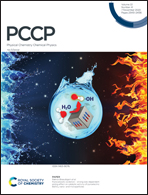Relating surface defect energetics with reactant gas adsorption during the photo-catalytic reduction of CO2 by partially hydrolyzed In2O3 nanorods†
Abstract
Photo-Induced Transient Current Spectroscopy (PICTS) is a versatile technique for measurements of defect state energies and densities in photo-active materials. It is suitable for investigating the surface-gas adsorbate behavior and the defect characteristics of defect laden In2O3−x(OH)y nanorods, having oxygen vacancies and hydroxide surface groups, under in situ reactor conditions of dark ambient temperature, dark 150 °C and photo-illuminated 150 °C, for the photo-assisted Reverse Water Gas Shift reaction. From glovebox-protected X-ray Photoelectron Spectroscopy and in situ PICTS measurements we determined that the reduction of CO2 is associated with heterolytic dissociation of H2 into In–H§− and HO–H§+ centres accompanied by an increase in average carrier trap energies; increased carbonate formation in a photo/thermal reactor state of H2 + CO2, and an average trap energy decrease of 0.11 eV from H2 to a CO2 + H2 mixture, which correlates with binding energy shifts of the OH shoulder of the O1s spectra. These results show the reactivity link between the various OH groups, oxygen vacancies and trap energies of In2O3−x(OH)y in the reactant gas atmosphere components.



 Please wait while we load your content...
Please wait while we load your content...